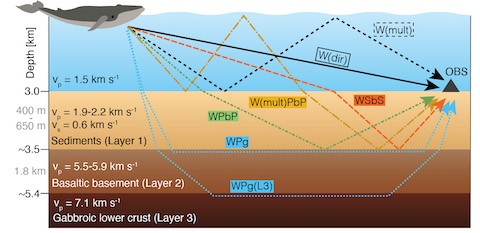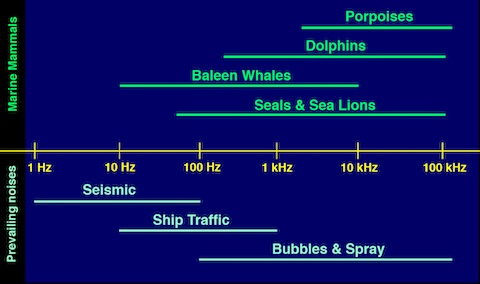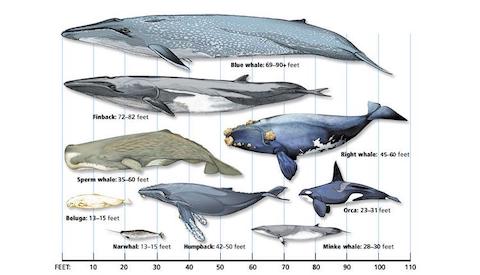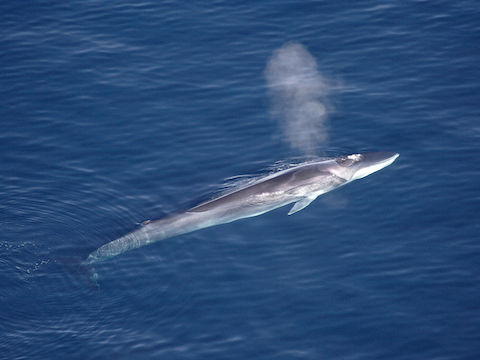
Credit: Oregon State University
Some of the loudest sounds in the ocean are air guns, fired by ships doing seismic studies of the seafloor.
The blasts can interfere with the communication of whales for a thousand miles around. So, scientists thought, what if they could use whales to do the studies instead?
In a seismic study, sound waves from a ship travel down through the water, through the ocean floor and into the geologic layers below.
They reflect off these layers and bounce back to other ships, where powerful computers analyze them to build geologic models of the Earth below the ocean.
The songs of fin whales, when converted from water to air, are as loud as a jet leaving an aircraft carrier, but in a similar low range as the air guns.
Scientists used hydrophones on the seafloor to record the whale song and its reflections, then fed that data through the same seismic computer programs.
Turns out the whale song did in fact penetrate the subsurface, down to about 8,000 feet, and could successfully be used to build similar geologic models.
Scientists now plan to analyze the higher-frequency songs of other whales, seals and dolphins to see if they can add detail to the models.
Air guns are still louder and penetrate deeper, so whale song won’t replace seismic ships for critical study.
But recording and analyzing the songs of sea mammals could allow geologic studies where seismic ships are too expensive or impractical.
Background
Synopsis: The ocean is full of sound, from natural marine noise to human clatter. Some of the loudest man-made sounds in the sea are blasts from air guns, which reverberate off of sediment interfaces beneath the ocean floor to reveal geologic layering. These blasts may disturb some types of marine life that depend on sound to navigate or communicate. Some of the loudest natural ocean sounds are made by large whales and can be just as loud as the human blasts. Recently some practical scientists adapted their approach to use whale song instead of air guns to image geology below the seafloor.
- Scientists who study ocean basins to understand their evolution or to search for natural resources rely on seismic imaging of geological layering and faulting to decipher geological history.
- Seismic surveys require a source of energy, such as an explosion. In offshore settings, this energy is created by large underwater blasts of compressed air from air guns.
- The energy created by a blast propagates away from the source, interacting with interfaces in the earth that reflect some of the energy back to the surface.
- Arrays of seismic receivers record the time it takes for the reflected energy to return to Earth’s surface, then complex seismic processing untangles the data to produce an image of the layering of the earth below the survey area.
- Scientists analyze slices of the data volume, similar to slicing a layer cake, and develop ideas about the sequence of events that must have occurred to result in the geometry evident in the slices. This helps them to confirm scientific hypotheses or to locate deposits of natural resources.

Credit: Discovery of Sound in the Sea
- Air gun blasts rival the loudest natural noises in the ocean and are carefully regulated because they can impact the hearing, vocalizations and behavior of nearby marine life.
- Man-made noise has the largest impact on animals that use the same frequencies to communicate.
- Air gun frequencies overlap with the frequency range that large baleen whales use to communicate, and the gun’s sound can travel more than 1,000 mi (1,600 km) in water.
- In the face of the uproar, some whales stop vocalizing, some intensify their calls, and some change the frequency of their vocalizations so they can be heard.
- Recently, researchers in Oregon have turned the whole seismic data acquisition concept upside down.
- They used the deep, booming calls of fin whales instead of air guns to map subsea sediments.

Credit: Smithsonian Ocean
- Fin whales (also called finback whales) are the second largest creature in the ocean (only their cousins the blue whales are larger), weighing about 80 tons (72,500 kg) and ranging from 65 to 80 ft (20–25 m) in length, about the size of an 18-wheeler tractor and trailer.
- Like blue whales, fin whales are baleen whales, with hundreds of plates of fingernail-like combs in their mouths instead of teeth. They take huge gulps of seawater teeming with krill into their expanding gullets and let the water drain out through the baleen plates, then swallow the prey that is left behind.
- Fin whales are dark grey with a lighter chevron and a distinct ridge behind the dorsal fin. The right side of their lower jaw is white, and the left side is black.
- Fin whales live throughout the global ocean, preferring higher latitudes in summer.
- Whaling took its toll on fin whales from the 1800’s through the 1970’s. Today the population is between 50,000 and 90,000.

Credit: Sigurd Risting, public domain, via Wikimedia Commons
- Male fin whales vocalize, probably to attract females, in one- to two-second pulses in the range of 15-30 Hz, but their volume is around 185 underwater dB (123 dB in air). Song sequences can last hours.
- This is one of the lowest frequency ranges produced by any animal and is barely perceptible to most humans, but the sound is one of the loudest natural sounds in the ocean, travelling for hundreds of miles.
- When converted from underwater to airborne dB, fin whale song is almost as loud as the sound of a container ship or a jet taking off from an aircraft carrier and is louder than a thunderclap or a chain saw.
- Air guns are louder, at up to 260 underwater dB (198 dB in air).

Credit: Aqqa Rosing-Asvid - Visit Greenland, CC BY 2.0, via Wikimedia Commons
- These extremely loud and low-frequency fin whale vocalizations can penetrate sediments as much as 8,200 ft (2,500 m) below the seafloor.
- Scientists from Oregon State University figured out that they could use the distinctive songs, just like the signature of the more powerful air gun blasts, to image layers of subsea sediments and volcanic rock.
- Using 54 existing hydrophone receivers deployed on the seafloor to monitor faults and earthquakes, they recorded the returns from fin whale song and processed them to image the thickness and orientation of sediments, basalt and gabbro under the seafloor.
- The whales cruised the area singing constantly for distances of 10 to 25 mi (15–40 km) over several hours. Each whale produced hundreds of individual bursts of song that were captured by the hydrophones.
- They may add in whale-song returns from different species to increase the frequency range of the data, improving the resolution of the seismic profiles.
- Air guns are higher energy than whale song, so they penetrate farther into the earth to image much deeper geological features and are reliable in areas of complex bathymetry (underwater topography), so whale song will not replace air guns any time soon.
- Using the passive seismic possibilities of whale song to study Earth is practical, environmentally friendly, sustainable—and free.

Credit: Discovery of Sound in the Sea

